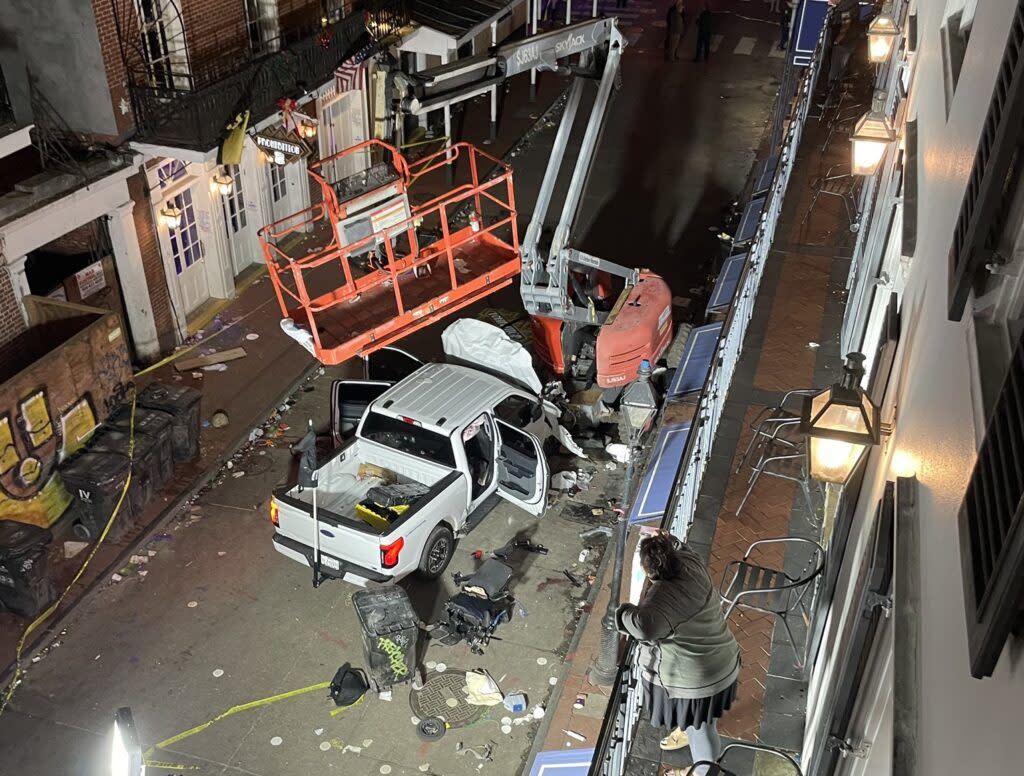
Bollard Repairs and Deadly New Year’s Attack: Was Timing of Safety Work a Coincidence?
Share
Bollard Repairs and Deadly New Year’s Attack: Was Timing of Safety Work a Coincidence?

Seven years ago, New Orleans began installing adjustable barriers at key intersections in the French Quarter to prevent vehicles from entering areas filled with pedestrians, particularly along the bustling Bourbon Street. These steel bollards, designed to protect the popular tourist area, were still being replaced when a deadly vehicle attack occurred early on New Year’s Day. A motorist drove a pickup truck into a crowd of revelers, killing at least 15 people. Seen in the video below:
Warning: This video contains graphic content that may be disturbing to some viewers. Viewer discretion is advised
The ongoing project to replace the bollards along about eight blocks of Bourbon Street, from St. Ann Street to Canal Street, began in mid-November, according to city documents. In areas where the old bollards were removed, temporary asphalt patches were installed, but officials have not clarified whether the intersection where the truck attack occurred was affected by the construction. One content creator, "Generation_x" believes that something does not sit right with the chain of events and the timing of these repairs. (video below)
City representatives stated that some of the older bollards had been “unreliable and non-operational.” While awaiting the installation of the new barriers, white gate barriers had been deployed, managed by the New Orleans Police Department (NOPD) to regulate vehicle access and improve safety.
On December 30, the city issued a traffic advisory regarding the bollard replacement project, informing the public that crews would be working until 2 p.m. on New Year’s Eve to minimize disruptions. The advisory noted that Bourbon Street remained fully open between Canal Street and Toulouse Street at that time.
Authorities claim to have video footage of the suspect prior to the attack in the French Quarter, a detail that’s starting to feel eerily familiar.
This isn’t the first time a high-profile attack has been followed by convenient video evidence. The recent 2024 Manhattan attack, where the CEO (Brian Thompson) of a major insurance company was killed, also featured similar footage, helping police quickly identify the assailant. However, the timing of these incidents, and how neatly they fit into the media narrative, has raised serious questions. Could these events be more orchestrated than they appear?
The official narrative surrounding the New Orleans attack suggests that the perpetrator may have ties to ISIS, a theory that is gaining momentum in the wake of the tragedy. However, this isn’t the first time ISIS has been invoked following brutal acts of violence. Recall the 2016 Pulse Nightclub massacre, where 49 people were killed, the 2015 San Bernardino shooting that claimed 14 lives, and the 2017 NYC bike path attack that left 8 dead—each of these tragedies was swiftly linked to extremist ideology. In all of these cases, the media coverage quickly turned toward Islamic terrorism. But did ISIS truly play a role in these attacks, or were they merely a convenient scapegoat to fit a growing narrative of fear?
Now, with the New Orleans attack, the same familiar rhetoric is resurfacing, once again pointing fingers at ISIS. But is this just another attempt to frame a complex tragedy within the same narrative? Or is there something deeper at play, with the specter of ISIS being used to distract from other possible motives and obscure the real truth behind these violent acts?
What makes the New Orleans attack even more puzzling is the video released by the attacker's brother, where he suggests that the violence was driven by a divorce in Texas. This claim feels oddly out of place. How could a personal dispute in another state, far removed from New Orleans, justify such extreme violence? The inconsistencies are hard to ignore. It almost seems like the brother is feeding a cover story—one that diverts attention away from something bigger at play. Could this "motive" be part of a larger effort to mislead the public about the true reasons behind the attack?
And then there's the unsettling connection being drawn between the New Orleans attacker and the 2024 Manhattan CEO killing. Some conspiracy theorists are now suggesting that the two incidents share a more profound link than just a coincidental rise in violence. Could these two attackers have been manipulated by the same shadowy forces? If there is indeed a connection between these two violent acts, it would point to something far larger than just isolated incidents of rage or terrorism.
It’s also important to question the pattern here. Just like with the Vegas shooter in 2017 and the subsequent media frenzy around his motives, the connections between these mass attacks seem too clean. The suspects in each case were presented as isolated individuals, but could they actually be part of a broader, coordinated campaign? If we follow the breadcrumbs of these incidents, it's hard to ignore the possibility that the true forces behind these attacks are being obscured by a narrative pushed by the media and government officials.
Could it be that these attacks are not the result of lone, disturbed individuals, but rather part of something much larger and more calculated? And if so, why are the media and authorities working so hard to suppress the real story, focusing instead on narratives that keep the public on edge and distract from deeper, more troubling truths?